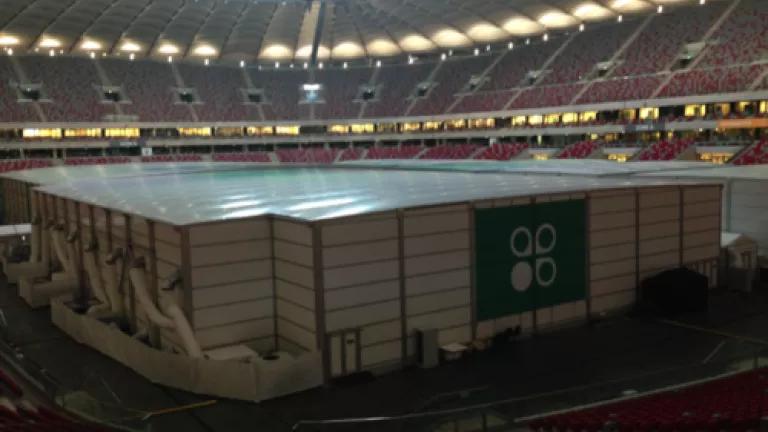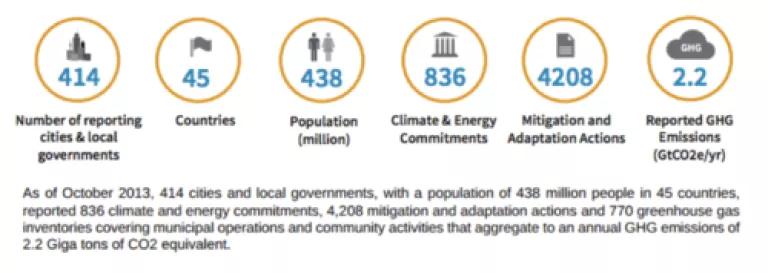
I have just returned from the most recent round of international climate negotiations in Warsaw. While many observers were discouraged and hundreds of civil society activists walked out on the talks, I came away somewhat more optimistic. I focused not on the formal negotiations, but instead on the myriad and multi-faceted climate actions that were showcased in meetings surrounding the negotiating rooms.
The national stadium in Warsaw was an interesting venue for this gathering of more than 10,000 officials, diplomats, advocates, experts, and others. The negotiations took place in white boxes erected on the playing field. Inside the boxes, it seemed as though there was an abstract zero-sum game underway being played by a set of the same outdated rules and norms that have stymied climate change negotiations for decades.
(Photo: Brendan Guy)
A much different picture emerged outside the “old architecture” of the negotiating boxes.
Outside the boxes, there were scores of “side events” where governments, business, civil society, and international organizations discussed the concrete actions and initiatives they are undertaking to combat climate change. These meetings focused on tangible actions that are happening right now, rather than in some distant and abstract future. The exuberant cloud of activity highlighted at the side events was a welcome change from the bogged-down conversations in the negotiating boxes.
The first event I attended was the “Caring for Climate Business Forum” where many leading businesses shared their concrete commitments and partnerships for scaling up climate action. IKEA outlined its commitment to 100% renewable energy powered operations by 2020. Electronics company Philips emphasized collaboration between the public and private sectors, as exemplified by their partnership with New York City and Buenos Aires to fulfill their commitments to replace all streetlights with LEDs over the next several years and reap substantial greenhouse gas and cost reductions.
At another side event, the governments of the Norway, the United Kingdom, and the United States, announced a new financing initiative for sustainable forest management. The three governments committed $280 million to the Initiative for Sustainable Forest Landscapes that will leverage additional private sector partnerships to reduce deforestation through the Tropical Forest Alliance 2020, a major commitment announced at the Rio+20 Conference. The new initiative will focus on sub-national level projects that work with a wide range of private actors, from large multi-national corporations to small enterprises, in order to incentivize sustainable land use practices that reduce emissions.
The United States hosted a side event showcasing its leadership in the creation and progress of the Clean Energy Ministerial. The Ministerial serves as a forum for countries to collaborate in “coalitions of the working” on 13 action-oriented and transformative clean energy initiatives. For example, the 21st Century Power Partnership helps countries work together on smart policies and programs for large-scale renewable energy and energy efficiency. The platform helps governments advance their own domestic priorities and partner with other governments and the private sector to focus on flexible problem solving rather than rigid negotiation. The 50 country partners involved represent 80% of global greenhouse gas emissions.
The UN climate secretariat organized a “Lighthouse Activities” side event to recognize numerous climate initiatives making an impact in three key areas: urban poor, women, and financing. In Uganda, women social entrepreneurs are engaging in micro-businesses to bring solar lanterns into households and displace harmful fuels. In Peru, artisanal brick makers have introduced energy efficient brick kilns to improve productivity and decrease emissions. The goal of showcasing these activities is to inspire and encourage other communities and countries to undertake similar efforts.
This year, for the first time at a climate negotiation, there was an entire day of events dedicated to the role of cities. Mayors and city managers spoke of how they are engaging a multitude of stakeholders to innovate, scale up, and lead on local climate action – often ahead of their national government counterparts. Platforms such as the carbonn Cities Climate Registry have recorded 8208 mitigation and adaptation actions through 836 climate and energy commitments that affect a combined population of over 400 million (see graphic below). My hometown of Vancouver, Canada was named Earth Hour Capital earlier this year for its outstanding climate actions that include carbon neutral buildings and climate friendly transportation. Rachel Kyte, Vice President for Sustainable Development at the World Bank, called the event the “can do room at the can’t do summit.”

Photo: ICLEI
The formal text negotiated in Warsaw did at least take note of this new architecture of non-globally-negotiated commitments to action. Countries agreed to “promot[e] voluntary cooperation on concrete actions” and share “best practices of cities and subnational authorities.” The UN launched a web-based portal on cooperative initiatives that highlights concrete actions being undertaken by governments, international organizations, and civil society around the world. The hope of the database is to serve for exchange of information and collaboration across initiatives, and to create new cooperative interactions. The UN also released a public, web-based platform on nationally appropriate mitigation actions that helps uncover where opportunities lie for enhanced cooperation and action.
While the world needs to stay on track to adopt a new ambitious climate change pact in Paris in 2015, the agreement alone certainly won’t be sufficient. As Christiana Figueres has emphasized in a video address at our recent “Rio+20 to 2015” Conference, climate change is not “going to be solved merely by a top-down approach.” Instead, the new architecture is much more dynamic and durable, resembling more of a spider’s web with a network of stakeholders and actions around the goal of protecting the climate.
One important stop on the road to Paris will be the UN Secretary-General’s Climate Summit on September 23rd, 2014. The architecture of the meeting will be different in that it is not another negotiation, but rather a “solutions-oriented” summit that will catalyze concrete actions on the ground from a broad range of partners and coalitions. Leaders from government, business, finance, and civil society have been invited to bring “bold announcements and actions” that focus on discrete deliverables.
The Climate Summit is precisely the type of meeting that NRDC first called for in the run up to Rio+20. We created the Cloud of Commitments website to call attention to various platforms where governments and other actors make promises to take tangible actions for which they can be held accountable. Leaders from all parts of society need to spend less time agreeing what to do and more time doing what they say they will do. The climate architecture needs to shift from a “culture of continuous negotiation” to a “culture of continuous implementation.”
All of these platforms and initiatives demonstrate there is a palpable “groundswell of action” and a growing willingness of people, business, and governments to take climate action, at all levels of society and policy. While there are many good architects, the new climate architecture is just beginning to emerge from the old boxes at Warsaw.

